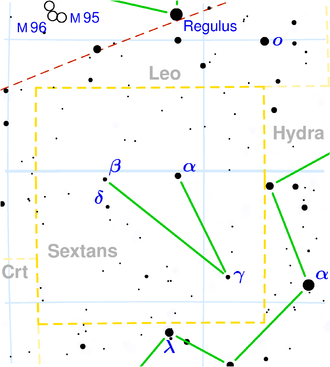NGC 3086
| Galaxie NGC 3086 | |
|---|---|
 | |
| NGC 3086 mit LEDA 1078506 (l.u.), SDSS-Aufnahme | |
| AladinLite | |
| Sternbild | Sextant |
| Position Äquinoktium: J2000.0, Epoche: J2000.0 | |
| Rektaszension | 10h 00m 11,0s[1] |
| Deklination | -02° 58′ 34″[1] |
| Erscheinungsbild | |
| Morphologischer Typ | Sb[1][2] |
| Helligkeit (visuell) | 13,9 mag[2] |
| Helligkeit (B-Band) | 14,7 mag[2] |
| Winkelausdehnung | 1,2′ × 0,4′[2] |
| Positionswinkel | 145°[2] |
| Flächenhelligkeit | 13,0 mag/arcmin²[2] |
| Physikalische Daten | |
| Rotverschiebung | 0.022482 ±0.000090[1] |
| Radialgeschwindigkeit | (6740 ±27) km/s[1] |
| Hubbledistanz vrad / H0 | (294 ± 21) · 106 Lj (90,2 ± 6,3) Mpc [1] |
| Geschichte | |
| Entdeckung | Albert Marth |
| Entdeckungsdatum | 22. Januar 1865 |
| Katalogbezeichnungen | |
| NGC 3086 • PGC 28924 • CGCG 008-012 • MCG +00-26-003 • 2MASX J10001097-0258343 • LDCE 693 NED002 | |
NGC 3086 ist eine Spiralgalaxie vom Hubble-Typ Sb im Sternbild Sextant südlich der Ekliptik. Sie ist schätzungsweise 294 Millionen Lichtjahre von der Milchstraße entfernt und hat einen Durchmesser von etwa 105.000 Lj.
Im selben Himmelsareal befinden sich u. a. die Galaxien NGC 3083, NGC 3090, NGC 3092, NGC 3093.
Das Objekt wurde am 22. Januar 1865 vom deutschen Astronomen Albert Marth entdeckt.[3]
Weblinks
Einzelnachweise
Auf dieser Seite verwendete Medien
Autor/Urheber: Sloan Digital Sky Survey, Lizenz: CC BY 4.0
The sky image is obtained by Sloan Digital Sky Survey, DR14 with SciServer.
Angle of view: 4' × 4' (0.3" per pixel), north is up.
Details on the image processing pipeline: https://www.sdss.org/dr14/imaging/jpg-images-on-skyserver/



